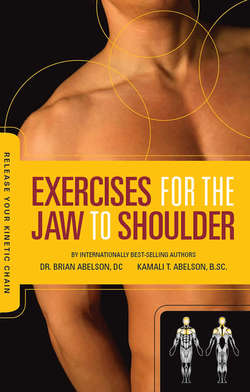Читать книгу Exercises for the Jaw to Shoulder - Release Your Kinetic Chain - Dr. Brian James Abelson DC. - Страница 29
На сайте Литреса книга снята с продажи.
Case Study - Shoulder Kinetic Chain
ОглавлениеOne of the best ways to explain the shoulder’s kinetic chain relationship, and some key therapeutic concepts, would be to introduce you to the case history of a young baseball pitcher by the name of Josh – a very talented pitcher with great potential in the game.
Josh presented to our clinic with complaints of shoulder pain with intermittent bouts of neck and jaw pain. He had a slowly progressing shoulder injury that severely affected his pitching speed and accuracy. To say the least, he was very distressed by the increasing pain and decreasing performance in his sport.
I ran Josh through the usual orthopedic and neurological tests, and found that they all showed negative (no significant findings). With hands–on palpation, I could feel muscle tension throughout the shoulders, neck, and jaw. There were no apparent signs of muscle tears, impingement syndrome, or overt muscle weakness.
We then went outside and I took a video of Josh pitching a few balls. A video analysis is a great method for obtaining biomechanical information that is not easily identified with standard tests. During the video analysis, I looked at each section frame–by–frame.
You can break down the phases of a baseball pitch into: windup, late–cocking, acceleration, and follow-through. Here is what I saw on Josh’s video.
Windup Phase - During this phase, the pitcher simultaneously flexes the torso, and lifts the lead foot off the ground.
At this stage, Josh’s left hip seemed to be restricted and his weight seemed to shift a little too much to the right, as if he were off balance. This indicated a possible muscle imbalance or a problem with his core stability.
Late-Cocking Phase - During this phase, the lead foot makes contact with the ground and the shoulder is cocked back (with maximum external rotation and abduction).
On observing this motion, I noticed that Josh’s shoulder didn’t seem to glide back (retract) very well.
This lack of backward motion (retraction) is often caused by tight pectoralis muscles or a weakness in the rhomboids, trapezius, or serratus anterior muscles.
Acceleration Phase - During this phase, the shoulder must be in a stable position for maximum acceleration.
I noticed that Josh’s arm seemed to move in an abnormal pattern, moving slightly out to the side.
Abnormal motion patterns (dyskinesis) are a common occurrence with chronic shoulder problems and become a matter of concern when this pattern continues for long periods of time.
Follow Through Phase - During this phase, the ball is released, the arm internally rotates, and then is pulled in towards (adduction) the body. These actions are controlled by the trapezius, rhomboids, posterior deltoid, serratus anterior, and the teres minor muscles.
With Josh, I noticed that his upper arm (proximal humerus) seemed to move a bit too far forward (protracted) from his shoulder joint.
This is a concern since excessive forward-shoulder motion is often related to a condition known as hyperangulation. This condition is often linked to shoulder impingement syndromes and is common in pitchers or any sport where an overhead action is required.
This was an interesting case since a simple video analysis of Josh’s shoulder problem quickly showed issues within three key kinetic chains.
His hip and core were unstable creating abnormal compensations throughout his body.
His restricted ability to move his shoulder back (retract) showed that he had weak posterior shoulder muscles and restricted, inflexible chest muscles.
The hypermobility when moving the shoulder forward indicated instability in the shoulder joint.
The developing instability in his shoulder was setting him up for a future chronic shoulder injury (impingement syndrome).
Fortunately Josh’s case was quite easy to resolve. He required a short series of treatments with Active Release Techniques to release the restrictions in his tissues. This was accompanied by a combined series of jaw, neck, shoulder, core, and hip exercises that helped to increase flexibility in restricted structures, increase strength in weakened structures, and retrain his neuromuscular systems.
